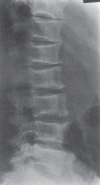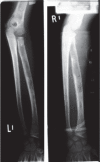Osteoarticular involvement in sickle cell disease
- PMID: 23049406
- PMCID: PMC3459393
- DOI: 10.5581/1516-8484.20120036
Osteoarticular involvement in sickle cell disease
Abstract
The osteoarticular involvement in sickle cell disease has been poorly studied and it is mainly characterized by osteonecrosis, osteomyelitis and arthritis. The most frequent complications and those that require hospital care in sickle cell disease patients are painful vaso-occlusive crises and osteomyelitis. The deoxygenation and polymerization of hemoglobin S, which results in sickling and vascular occlusion, occur more often in tissues with low blood flow, such as in the bones. Bone microcirculation is a common place for erythrocyte sickling, which leads to thrombosis, infarct and necrosis. The pathogenesis of microvascular occlusion, the key event in painful crises, is complex and involves activation of leukocytes, platelets and endothelial cells, as well as hemoglobin S-containing red blood cells. Osteonecrosis is a frequent complication in sickle cell disease, with a painful and debilitating pattern. It is generally insidious and progressive, affecting mainly the hips (femur head) and shoulders (humeral head). Dactylitis, also known as hand-foot syndrome, is an acute vaso-occlusive complication characterized by pain and edema in both hands and feet, frequently with increased local temperature and erythema. Osteomyelitis is the most common form of joint infection in sickle cell disease. The occurrence of connective tissue diseases, including rheumatoid arthritis and systemic lupus erythematosus, has rarely been reported in patients with sickle cell disease. The treatment of these complications is mainly symptomatic, and more detailed studies are required to understand the pathophysiological mechanisms involved in the complications and propose more adequate and specific therapies.
Keywords: Anemia, sickle cell/complications; Arthritis; Bone diseases/etiology; Hemoglobin SC Disease; Osteomyelitis; Osteonecrosis.
Conflict of interest statement
Conflict-of-interest disclosure: The authors declare no competing financial interest
Figures








References
-
- Wang WC.Sickle cell anemia and other sickling syndromes In: Greer JP, Foerster J, Rodgers GM, Paraskevas F, Glader B, Arber DA, Means Jr RT.Wintrobe`s Clinical Hematology. 12th ed Philadelphia: Lippincott Williams & Wilkins; 2009. p.1038-82
-
- Schnog JB, Duits AJ, Muskiet FA, ten Cate H, Rojer RA, Brandjer DP.Sickle cell disease: a general overview. Neth J Med. 2004; 62 (10): 364-73 - PubMed
-
- Loureiro MM, Rozenfeld S.[Epidemiology of sickle cell disease hospital admissions in Brazil]. Rev Saúde Pública. 2005; 39(6): 943-9 Portuguese - PubMed
-
- Almeida A, Roberts I.Bone involvement in sickle cell disease. Br J Haematol. 2005; 129(4): 482-90 Comment in: Br J Haematol. 2006;133(2):212-4 - PubMed
-
- Babela JR, Nzingoula S, Senga P.[Sicke-cell crisis in the child and teenager in Brazzaville, Congo. A retrospective study of 587 cases]. Bull Soc Pathol Exot. 2005; 98(5): 365-70 French - PubMed
LinkOut - more resources
Full Text Sources
